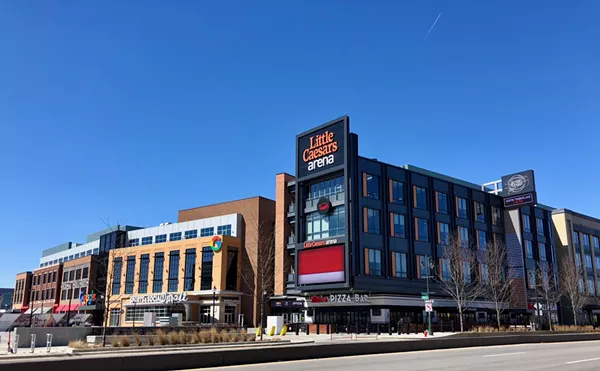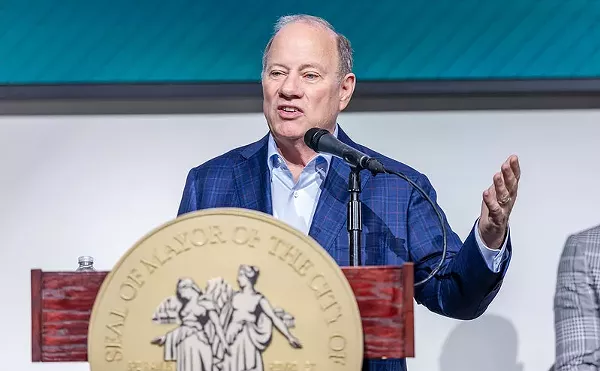
Audio By Carbonatix
[
{
"name": "GPT - Leaderboard - Inline - Content",
"component": "35519556",
"insertPoint": "5th",
"startingPoint": "3",
"requiredCountToDisplay": "3",
"maxInsertions": 100,
"adList": [
{
"adPreset": "LeaderboardInline"
}
]
}
]
The 35-acre parcel on the southeast corner of Woodward Avenue and Eight Mile Road would seem to be valuable real estate at the intersection of two of Detroit's main thoroughfares. Once owned by the state, over the years, developers have had plans for a campground, parking lot, hotels and various retail outlets there. About 10 years ago there was even a plan to build a new Detroit Public School there.
But the high-profile property has been fallow for decades.
In 2004, the Detroit City Council approved development of a mall there. Seven years, three mayoral administrations, a couple of developers, some concept changes, and one Great Recession later, it looks like the Gateway Marketplace, an open air mall, will finally get built at Woodward and Eight Mile.
"Around the country, in any city and even suburban places, commercial real estate has been struggling for quite a few years," says Ricardo Solomon, a former Wayne County Commissioner and one of the developers for Gateway. "It's not unusual to see projects taking longer than one thought. This development is not unusual at all. Things are taking longer than was envisioned in lots of places."
Detroit City Council member Saunteel Jenkins, who heads the committee on planning and economic development, says, "I think it's closer to happening now than it's ever been," of the development that has so far been long on promise and short on delivery.
But after all the time and changes, it's a vastly different concept than was envisioned even two years ago, when it was named the Shoppes at Gateway Park, and an artist's rendering displayed a village-like setting with retail store facades that looked like cottages with greenery popping up all around. It was something you might expect to see in the shopping area of a city such as Rochester.
There's always a gap between concept and reality. But the latest rendering, distributed at a recent meeting, pretty much looks like two strip malls with a large parking lot between them. That's just the look. The fact that there are Meijer and Marshalls stores lined up to be part of the mall shows that this is no mere strip mall.
It would be nice if the design sent the same message. That was pretty much the conclusion of community members at the meeting, which was technically a brownfield development hearing that would lead to tax breaks for Gateway.
Folks generally welcomed the idea of getting something going there, but were concerned that it be a better asset to the neighborhood in terms of walkability, eye appeal and the kinds of stores and restaurants brought in. Developers mentioned talks with McDonald's to locate there. But there is already a McDonald's at the corner of Seven Mile Road and Woodward Avenue, and another on Woodward just south of Nine Mile Road. Do we need a third location at Eight Mile?
"We need a nice sit-down restaurant there," says Harold Varner, who lives on Hamilton in the Palmer Park area.
Varner, the principal of the architectural firm Varner and Associates and a former director of development for the city of Detroit, designed Cobo Hall and the Wright Museum of African American History in addition to many other area projects. He knows the development game.
"Woodward is our main street, and we want it to be beautiful," Varner says. "A parking lot on Woodward, that's totally unacceptable. That's a necessary facility but let's not destroy our city at the same time. You can have an entry off Woodward but no parking on Woodward. They need to replan the way the market has been planned. Whoever did the planning wasn't thinking. That's the entrance to the city. The main service entrance ought to be off of Eight Mile Road. If the big box [Meijer] is turned just 90 degrees and the service entrance is put on Eight Mile, it would make a big difference. Somebody just plopped some buildings down and put parking in the middle and that's not acceptable.
"There are no buildings there to shield the view from Woodward; you're going to see all the guts [delivery docks, etc.] there. That's unacceptable. Malls have a lot of parking and you need to have it, but you don't have to feel like you're in a big parking lot. They need some good urban planner to help put it together. ... Ricardo is a friend of mine; he said they were going to talk about it so I'm sure they're doing some adjustments."
But Solomon seemed a bit recalcitrant on the subject. "That's not just my decision," he said, pointing out that the development team includes Elliott Hall, Marvin Beatty, Bernie Schrott and Southfield-based Redico, a national property management company.
Hearing Schrott's name gives me pause. In 2000 and 2001, Metro Times detailed a number of questionable business dealings that Schrott was involved in, including connections with a drug ring, accusations of fraud in a Bahamian casino deal and a plan to sell the land at Woodward and Eight Mile to Detroit Public Schools at a vastly inflated price. However, there are a lot of business deals done by persons of questionable character, and citizen concerns lean more toward the impact Gateway will have on the local community.
"For the most part we're going to probably stay with the direction that we're going," Solomon says. "Redico has been hired by us. They've done a lot of work with the city; they have a lot of familiarity with Meijer. We work in collaboration and they are managing the project on our behalf. We've had a number of changes."
Developers have looked at the local demographics, reporting that there are 185,111 households with an average income of $54,473 within a five mile radius of the development. That includes areas such as Ferndale and Madison Heights. Yet they don't seem to have done much in terms of engaging the surrounding community. At the brownfield meeting, Jason Fowler of the Woodward Avenue Action Association (WA3) said that this was the first his organization has seen of the plan. Fowler, whose WA3 vision includes "Inspiring architecture, quality streetscaping and beautiful public spaces that are well maintained, clean, safe [and] welcoming," says he is "disappointed with the design."
Others are concerned about the impact Gateway will have on the nearby Livernois Avenue of Fashion district, and on Mike's Fresh Market, which occupies the former Farmer Jack space at Livernois and Seven Mile. When Farmer Jack left the area, community organizations worked with Mike's to locate there.
Nobody seems to be saying that Gateway shouldn't be built, just that developers should be more sensitive to the local community. That seems to be fair, especially since the people of Detroit are footing the bill to create this place. Gateway is financed, in part, by the Detroit General Retirement System pension fund in addition to a variety of tax incentives.
"Mike's Fresh Market, he's going to be greatly impacted," Varner says. "He can't compete with them in prices. It can't be the same kind of market it is now. And the small stores on Livernois are going to be affected. That doesn't necessarily mean a bad thing; it may improve business in the community."
This is the conundrum we face in Detroit these days. We need development; we need jobs. One report says Gateway will create about 600 jobs. And it will generate taxes from an area that is not generating any economic activity. But do we have to take anything that comes down the pike? In this instance, that may be more the case than not.
Steve Douglas, owner of Renaissance Bowling Center on Woodward near the Gateway grounds, provides some perspective from the area east of Woodward, which is much more hardscrabble than the tony neighborhoods on the west side. "I bought this place in 1999. Since then the entire neighborhood has totally fallen apart," he says. "Why wouldn't you want something like this in your community? There's nothing but crime here."






